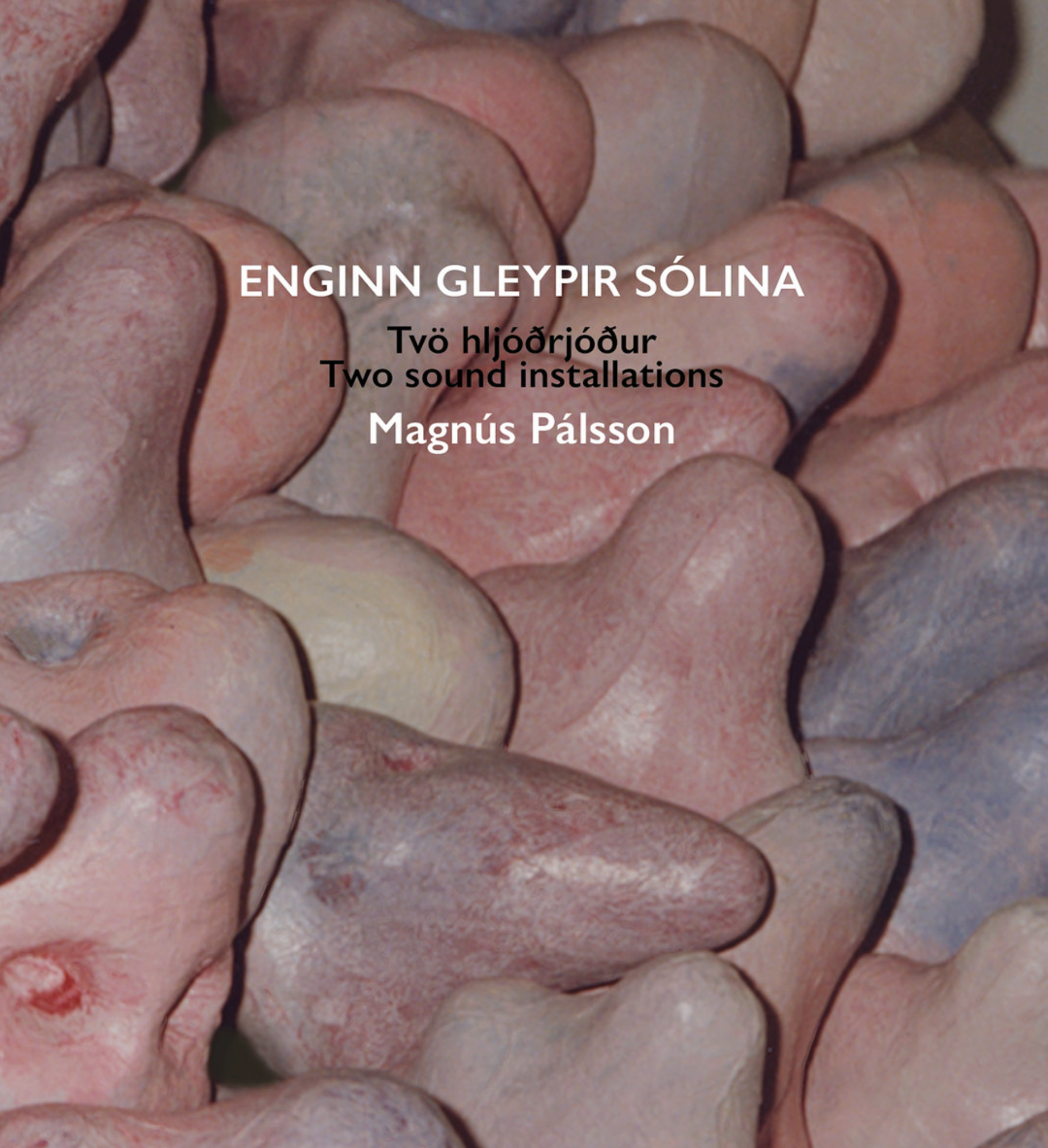REVIEW: Enginn Gleypir Sólina, Two Sound Installations by Magnús Pálsson
Cover of Enginn Gleypir Sólina, Two Sound Installations by Magnús Pálsson, image courtesy the artist and Mumbling Eye.
REVIEW
Enginn Gleypir Sólina, Two Sound Installations
by Magnús Pálsson
Text: Magnús Pálsson, Adam Buffington
Translations: Magnús Pálsson, Frances Cowan, Tumi Magnússon
Photos: Hannes Lárusson, Frances Cowan
CD Photo: Kristinn G. Harðarson
Design: Tumi Magnússon
Print: Prentmet Oddi, Reykjavik
CD Production: Myndbandavinnslan, Reykjavík
Performers: Baldvin Halldórsson, Eyvindur Erlendsson, Guðbjörg Thoroddsen, Guðrún Ásmundsdóttir, Karl Guðmundsson, Magnús Pálsson, Tumi Magnússon
Direction: Eyvindur Erlendsson
Sound Recording and Mixing: Júlíus Agnarsson
Supported by the Icelandic Visual Arts Fund
Published by Mumbling Eye, 2023
By Mána Taylor
Earlier this summer, I received a small book in the mail. A pinkish purple CD-booklet containing the recordings of two sound installations by Icelandic artist Magnús Pálsson, re-released by the archival label Mumbling Eye. Adam Buffington, who runs the label along with Magnús’ son Tumi, wrote that these are recordings of sound installations from an installation at Gallerí 11 in Reykjavik, which were exhibited in 1993. The piece begins with grunts, moans, sighs. Through the curtain of voices that sound like mist, a woman’s voice then clearly states “enginn gleypir sólina,” the title of the piece. This translates to “no one swallows the sun.” Voices continue with rhymes, onomatopeias, and sometimes reciting tales normally told to children, such as one about a mouse going into its hole.
In the book A Cultural History of the Avant-Garde in the Nordic Countries 1950-1975, the author Martin Humpál writes that “Magnús Pálsson – who was also among the founders of an influential experimental theatre group called Gríma (or Mask) – had written a sketch where a herd of thirty to forty horses was supposed to gather on stage in complete darkness.” In the CD liner notes, a quote from Pálsson himself echoes this sentiment of his artistic aims, “I feel that our age is the age of sound. Not sight. Sound is the most important force.”
Though prolific and well-known in Iceland, it was hard for me to find information on Pálsson’s upbringing. Ben Duvall, in the website New Rural, generously provided information through his own research. “Born in 1929, Pálsson’s influence on the development of contemporary art in Iceland is impossible to overstate.” I also learned that in 1980, Pálsson, represented Iceland in the 37th Venice Biennale, and soon after he founded The Icelandic Sound Poetry Choir (Nýlókórinn). Many of the words recited have stories attached to them in the small CD booklet. “No one swallows the sun though he chews the moon like fish” is something the artist remembers hearing from a physician. Other sayings are either found texts or anecdotes from childhood or family members. Through these, Pálsson creates an oral history of rhymes and absurd phrases.
Even through the mumbling cacophony of the voices in this piece, the personalities and stories are felt despite the lack of visuals. Ten minutes into the first track, the voices start repeating “Já” (the word for yes in Icelandic) in different tones, emotions, and vocal ranges. Being half-Icelandic myself, I am reminded of an Icelandic saying that you can have a whole conversation with the word yes — breathing it in as you say it, letting it sing, exhaling your já out, either quickly or slowly. I sometimes listened to my grandmother talk on the phone as she just answered with these different variations of “já,” each of them with their own unique sound.
Listening to this sound installation from 1993 does feel like watching a performance in the dark. Magnús Pálsson’s sound sculptures are rich textures that reflect on the elasticity of our voices and the eccentric music we could be making with our own mouths. If we let sound become a visual medium, there is so much our ears can open up to. It can feel uncomfortable to listen to sounds that aren't music; such as groans and grunts, wails and sobs. It can also feel strange to listen to a language that is not your own.
Adam Buffington once said “I hope Mumbling Eye becomes a platform to promote greater awareness of Icelandic art and artists, for listeners in both Iceland and especially abroad.” I similarly hope that you will open up your ears to the delightful world of Magnús Pálsson.
BRIDGE DISCOVERY PLAYLIST:
ON BANDCAMP
Like what you’re reading? Consider donating a few dollars to our writer’s fund and help us keep publishing every Wednesday.



